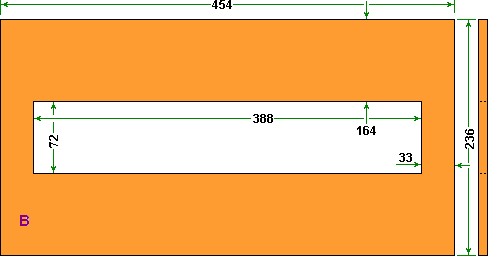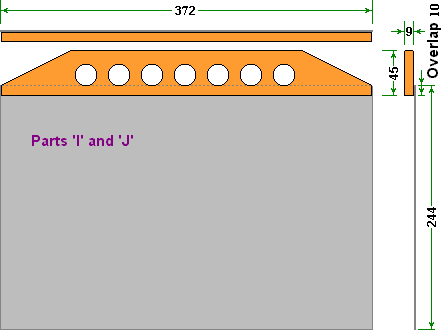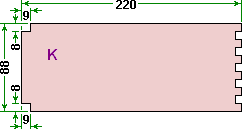Standard Lid
Cell Cup Lid
Cage Filling Lid
|
|
|
|---|
|
Standard Lid Cell Cup Lid Cage Filling Lid |
Special Swarm Box Lid
|
|---|
Scale of all drawings on this page is 1 mm per pixel, projection is third angle (American). Standards used are British 'National'. All Dimensions in Millimetres. |

|
|---|
Unlike the cell plug lid, which can have the hole covered by a bystander's finger or a slip of wood, while the cell is grafted, thus not losing any bees from the interior of the box. This lid has a large slot in the centre which would lose a considerable portion of bees when it was opened to admit a frame of grafted cells. Although the design is a little complicated and requires accurate carpentry to function smoothly, the extra work is worthwhile as it is simplicity itself when in operation and use of this method will streamline any queen rearing operation. The slide in aluminium plates act rather like the 'dark slide' of a plate camera, when the frame of grafts has been placed and the slot cover slid into position the aluminium sheets can be withdrawn and the bees can get at the grafted cells, but cannot get out of the 2 mm wide slits.
Although designed specifically to fit the other items in this swarm box section of the website, particularly the Marburg version of box, the principle can be used to modify existing swarm boxes that might be available.
Parts List
| Part | Qty | Length | Width | Thickness | Material | Description |
|---|---|---|---|---|---|---|
| A | 2 | 214 | 22 | 9 | Ply | Trapping Strip |
| B | 1 | 454 | 236 | 9 | Ply | Main Plate |
| C | 2 | 236 | 33 | 10 * | Ply | End Housing |
| D | 2 | 388 | 164 | 10 * | Ply | Fillet |
| E | 2 | 454 | 164 | 9 | Ply | Top Strap |
| F | 2 | 454 | 10 | 9 | Ply | Slot Guard |
| G | 1 | 454 | 54+ | 9 | ply | Slot Cover |
| H | 1 | W.H.Y. | W.H.Y. | W.H.Y. | W.H.Y. | Slot Cover Handle |
| I | 2 | 372 | W.H.Y. | W.H.Y. | ply | Aluminium Slide Handle |
| J | 2 | 372 | 244 | 1.5 or 2 | Aluminium | Aluminium Slide Panel |
| K | 2 | 220 | 88 | 6 | Ply | Case End |
| L | 1 | 388 | 88 | 6 | Ply | Case Bottom |
| M | 4 | 214 | 8 | 8 | Ramin | Inner Slot Guides |
| N | 4 | 205 | 8 | 8 | Ramin | Outer Slot Guides |
| O | 4 | 70 | 56 | 33 | Softwood | Handling Blocks |
| O (Alternative) | 2 | 454 | 56 | 28 | Softwood | Handles |
This drawing shows the position that a cell frame would take outlined in red. Only one aluminium slide is shown in position. The fourth view is to show elements of construction. Some parts are coloured in blue tints for clarity.

Various parts that require shaping are detailed in the drawings below, items like the handle of the slide in slot cover are not detailed as they can be made from whatever is to hand, (W.H.Y. = What have you?) the holes shown in the slot cover handle and the aluminium slide handles are there for grip and to remove weight, part 'D' can also be lightened by drilling, hole sawing or trepanning several holes. the 6 mm plywood pieces that form the outer casing of the central frame holding portion are shown comb jointed for strength and simplicity, use whatever jig you have available to perform this function.
This Main Top Plate uses the same blank piece of ply as those used on the Standard Lid, Cell Cup Lid and Cage Filling Lid, but has a central aperture. |

|
|---|
This piece allows for accurate positioning of top bar ends. Noted as being 10 * mm thick in the parts list above, it is made from 9 mm ply and fitted using PVA glue and a cardboard shim to make up to 10 mm, this is because some frame lugs are slightly over the standard 9 mm thickness. Part 'D' also needs to be fitted using a similar shim to maintain the 10 mm thickness. |

|
|---|
|
|
Parts 'I' and 'J' are assembled into the slides pictured at right, using small countersunk screws through the 10 mm overlap. Aluminium thickness can be anything between 1.5 mm and 2 mm (16 SWG to 14 SWG). Other sheet materials can be used if they are to hand, providing that they are stiff enough to maintain their shape. The shaping that I have shown is arbitrary, which is why it has not been dimensioned, but such shaping reduces weight, while still maintaining stiffness. |

|
|---|
The case ends are only 6 mm thick, but are well stiffened by the ramin strips that form the guide slots for the edges of the aluminium blanking panels. |

|
|---|
This Case bottom for the frame receiving cavity is potentially able to distort, because it is thin and quite long, should this happen a strip of softwood can be applied on the underside (glued and screwed), which will stiffen it adequately. |

|
|---|
Pairs of this alternative style of handle can be used, which will retain the ability to stack complete boxes when out of use, the edges of the portion that will be gripped can be shaped for greater comfort. |

|
|---|
Part 'E' may be dispensed with completely and part 'D' can be just a strip 19 mm wide, in which case there is no need for lightening holes in part 'D'.
My apologies are given for the degree of complexity and precision required to make this item, but if you can come up with a simpler design, that does not entail extensive machining of parts, I would be glad to add any such simplified design to these web pages.
To use this item place a couple of frames in the Marburg box that have nectar and pollen as well as open brood, but no eggs or larvae under four days old, in positions close to the sides of the insert case, fit the lid with the aluminium slides in place, open the chute/funnel and shake in the bees from five or six frames. Close the chute, graft your frame of cells and place in the centre cavity, fit the closure plate and pull out the aluminium slides. The captive bees can only work on the grafted cells that you have provided, because all other larvae are too old. If the frames with open brood are short of nectar, then a frame feeder with thin syrup can be provided in one of the outer frame positions within the box in addition to the two frames of open brood.
Written... 12 to 17 February 2006,
|